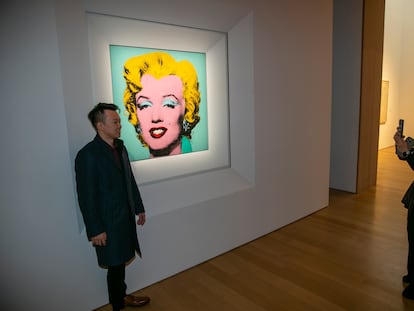Museums say goodbye to the ‘blockbuster’: A selection of the best exhibitions of the season
Retrospectives of great masters are no longer obligatory. From Barcelona to Venice, Madrid, Valencia, New York, London, Paris and Berlin, here are the most interesting shows in 13 different cities
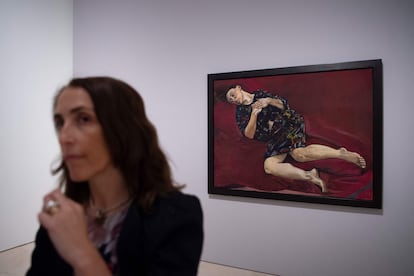
This spring, after two years of activities restricted by the pandemic, museums have finally achieved a longed-for normality, a word that we have already learned to pronounce with caution and apprehension. They have recovered an ambition worthy of the days before the virus. And they have moved away from the dogma of the blockbuster exhibition, the great retrospectives of painting masters designed for massive audiences.
Let’s remember what happened in museums in 2019. In Paris, a large exhibition on Leonardo da Vinci triumphed at the Louvre, while an El Greco show drew crowds at the Grand Palais. In London, the Tate surrendered to Van Gogh, the National Gallery paid homage to Gauguin and the British Museum opened its rooms to Munch. Meanwhile, in New York, the monumental reopening of MoMA took place. The event was announced as a definitive farewell to the canon of yesteryear, with the new inclusion of groups long ignored in the history of modernity. The gesture came from a museum long financed by blockbusters. The Louvre, the world’s busiest museum, had surpassed 10 million visitors in 2018, thanks to Delacroix and Beyoncé, and reached that figure again the following year.
And then it happened. In 2020, the Louvre had 2.7 million visitors. In 2021, 2.8 million. The paradigm shift caused by the lockdown and the sharp drop in tourism have jeopardized the finances of every institution, but it has also had a positive side effect: the highly publicized retrospectives of great masters no longer seem mandatory. They have given way to more modest, less showy and less expensive exhibitions, which have allowed museums to fulfill functions that they had forgotten: the association of unexpected ideas, dialogue between disciplines, the exploration of unknown names and places from the past and the present. This is a subjective selection of some of them, city by city (and in alphabetical order), commented on in EL PAÍS by Jacinto Antón, Carlos Córdoba, Gloria Crespo McLennan, Mario de Jaime, Rafa de Miguel, Silvia Hernando, Ianko López , Ángela Molina, Javier Montes, Javier Rodríguez Marcos, Jesús Ruiz Mantilla, María Antonia Sánchez-Vallejo, Iker Seisdedos and Victoria Zárate.
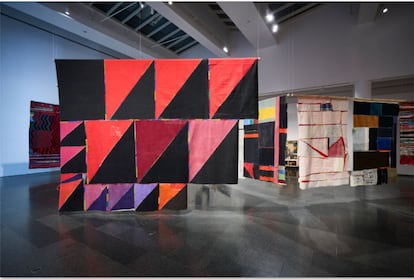
Barcelona
The Macba and the CCCB, neighboring institutions in the Raval neighborhood, have just inaugurated what already seem like two of the year’s best exhibitions. The former pays tribute to Teresa Lanceta, a pioneer of textile art in Spain who, at 70 years old, is now finally receiving the honors that have eluded her throughout her career. Meanwhile, the CCCB is dedicating a major exhibition to Francesc Tosquelles, the Catalan Republican who fought to reform psychiatric institutions and de-stigmatize mental illness. The show is demanding, dense and exciting. In the autumn it will appear at the Reina Sofía in Madrid.
Berlin
The recent restoration of Mies van der Rohe’s Neue Nationalgalerie comes with a new in situ installation by Barbara Kruger on the ground floor. Most notable are two videos that mock the two moral guides of the average American: the 1787 Constitution and the marriage vows. In addition, the C/O Center, specialized in photography, delves into the work of Susan Meiselas, the Magnum photographer who toured the west coast of the United States in the 1970s to portray the underworld of strip clubs.
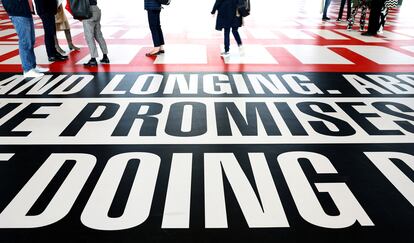
Bilbao
In “Jean Dubuffet: Fervent Celebration,” the Guggenheim covers the entire career of the French painter and sculptor, from his earliest works conceived during the Nazi occupation of Paris, to his last series in the 1980s. All of them demonstrate the artist’s desire for a change of perspective in art, in the literal and figurative sense. Meanwhile, Azkuna Zentroa presents “A Voice for Erauso. Epilogue for a Trans Time,” an exhibition by the Cabello/Carceller collective, curated by Paul B. Preciado and centered on the figure of the lieutenant nun who participated in the conquest. She was a nun, a soldier and an icon.
Córdoba
The agreement signed with TBA21, chaired by Francesca Thyssen, brings to C3A in Córdoba (Spain) a selection of 40 works from the foundation’s impressive collection. It includes names such as Ai Weiwei, Olafur Eliasson, Camille Henrot, Sarah Lucas and John Akomfrah, in a presentation that attempts to refute Malthus’ thesis on scarcity. Its title is “Abundant Futures.”
London
In a 1959 interview, Walt Disney stated that his aspiration was not to make art: “I make movies in the name of entertainment, and then the teachers come and tell me what they mean.” A show at the Wallace Collection now reveals that many of Disney’s films contained references to European culture and literature, especially the French tradition of the 18th century. Meanwhile, the National Gallery celebrates the Renaissance harmony of Raphael with an exhibition that brings together more than 90 works by the Italian artist. Delayed by the pandemic, the show represents a vestige of the world of before.
Málaga
The tortured figures of Paula Rego have returned. The Portuguese painter, based in London since the fifties, has her own room at the new Venice Biennale and is starring in a retrospective at the Picasso Museum in Málaga, in southern Spain. In a time saturated with images, Rego maintains a surprising power when it comes to representing the mistreatment to which women’s bodies have been subjected. It also contains a work from 1961 that summarizes all her poetry: “When we had a house in the country we gave wonderful parties, and then we went out and killed Blacks.” The name itself merits a visit.
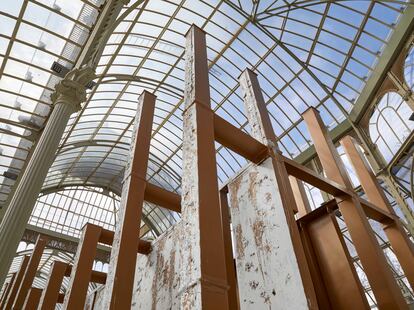
Madrid
With Vivian Suter’s extraordinary exhibition at the Palacio de Velázquez closed, we are left with three architecturally inspired works. First, Carlos Bunga’s cardboard trompe-l’oeil intervention in the Palacio de Cristal makes the viewer doubt what is solid and what is fragile. Second, Guillermo Mora’s piece in Alcalá 31 also plays with architecture to destabilize our certainties and includes an interesting selection of recent works. Third, Álvaro Perdices’s work at CA2M (Móstoles) uses the discipline to question the recent past of the Spanish state.
New York
Since 1932, the Whitney Biennial has served as an indicator of the health of contemporary art in the United States. Its new edition, recently inaugurated after a three-year hiatus, includes art that is mostly young and made during the pandemic. Consequently, it is more somber than usual, full of reflections on racial violence and social division, according to the first critics. This week everyone was talking about the Met Gala, but somewhat less about the exhibition that gives it occasion: “In America,” the great annual fashion exhibition of the Costume Institute of the New York museum, a blockbuster in which Martin Scorsese, Sofia Coppola and Tom Ford have participated. This time, it returns to the glamor of the golden age.

Paris
As the Pompidou Center prepares to open a great exhibition on Germany in the 1920s, an exhibition at the Musée de l’Orangerie gives an exciting twist to impressionism. It reveals that many of the movement’s masterpieces were originally conceived as objects and decorative pieces, calling into question the dusty hierarchies that continue to reign in art. In addition, the Museum of Modern Art in the French capital remembers Toyen, a mostly forgotten Czech artist who ended up in Paris, where she was linked to the Surrealists. Her hallucinatory figuration seems more influential in art today than that of the supposed masters.
San Sebastián
In the wake of the recent rediscovery of the work of Hilma af Klint, the Swedish painter who made abstract paintings before Kandinsky and Kupka, museums continue to investigate pioneers who were cornered in official history. Among those newly recovered artists is Swiss Emma Kunz, whose drawings contain visual richness ahead of their time – and may have predicted the atomic bomb. An exhibition at the Tabalakera in San Sebastián, in northern Spain, vindicates her legacy by putting her work in dialogue with contemporary artists.
Seville
Luis Gordillo returns to his hometown with an exhibition at the Espacio Santa Clara. There he exhibits a long series of works that, despite his 87 years, seem younger and more innovative than those of many millennial artists. The veteran also gives his verdict: Duchamp is eating Picasso. The million dollar question is whether that is good or bad.
Valencia
The IVAM is presenting two of the exhibitions that will mark this 2022. The first is “Art and Life,” which compares the works of Anni and Josef Albers and observes the influence of their geometric compositions, which left their mark from the Bauhaus to Yale. And then there is the work of Zanele Muholi, a “visual activist” who documents the lives of LGBTIQ+ people in her native South Africa and elsewhere on the continent and around the world, often through posed self-portraits and iconographic fashion.

Venice
This year’s Venice Biennale, which opened at the end of April, has once again made the Italian city the art capital this spring. Among the official program, two offerings stand out: the main exhibition, “The Milk of Dreams,” with its dialogue between historical surrealism, the absurdity of the present and the prospect of a hybrid future, and the applauded Spanish pavilion by Ignasi Aballí, the moral champion of an edition in which Russia is not present, but Ukraine is.
Tu suscripción se está usando en otro dispositivo
¿Quieres añadir otro usuario a tu suscripción?
Si continúas leyendo en este dispositivo, no se podrá leer en el otro.
FlechaTu suscripción se está usando en otro dispositivo y solo puedes acceder a EL PAÍS desde un dispositivo a la vez.
Si quieres compartir tu cuenta, cambia tu suscripción a la modalidad Premium, así podrás añadir otro usuario. Cada uno accederá con su propia cuenta de email, lo que os permitirá personalizar vuestra experiencia en EL PAÍS.
¿Tienes una suscripción de empresa? Accede aquí para contratar más cuentas.
En el caso de no saber quién está usando tu cuenta, te recomendamos cambiar tu contraseña aquí.
Si decides continuar compartiendo tu cuenta, este mensaje se mostrará en tu dispositivo y en el de la otra persona que está usando tu cuenta de forma indefinida, afectando a tu experiencia de lectura. Puedes consultar aquí los términos y condiciones de la suscripción digital.
More information
Últimas noticias
Iranian women are also defying the taboo of riding motorcycles (and without a license)
David Bowie, the galactic thinker who encouraged us to break new ground
John Berger and the loss of rural culture
From police officer to bloodthirsty kidnapper: Terror in Mexico during the years of ‘The Ear Chopper’
Most viewed
- David King, chemist: ‘There are scientists studying how to cool the planet; nobody should stop these experiments from happening’
- Reinhard Genzel, Nobel laureate in physics: ‘One-minute videos will never give you the truth’
- Oona Chaplin: ‘I told James Cameron that I was living in a treehouse and starting a permaculture project with a friend’
- Mexico completes its trade shift with the entry into force of tariffs on China and countries without trade agreements
- Sinaloa Cartel war is taking its toll on Los Chapitos

